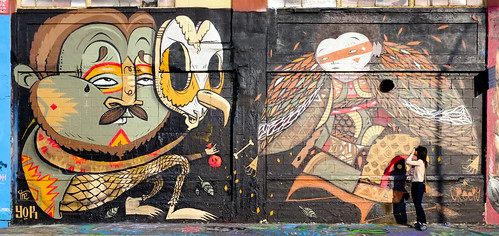Bottom-line: One heck of a point and shoot- not quite a DSLR at a mid-level DSLR price with a learning curve
Pros: stylish body, 35mm (equivalent) f/2 lens, sharp, good in low light, large APS-C, all about the image quality, small and light, leaf-shutter (very quiet)
Cons: learning curve to be happy with this camera, stupid AF, long minimum-focus-distance for non-macro, sometimes confusing user-interface, not quite good for 100% on the computer, expensive
Going on a trip? Hiking? Street-photography? Hate all that DSLR-lugging and insecurities about losing/damaging your DSLR?
Here comes the Fujifilm X100. Why do we care? Fujifilm is known to make very nice films and sensors- excelling in low light performance. We can see that clearly in this camera. I will break this down to a few key points:
Camera Body: Small, light, and retro. This is largely what you are paying for. The stylish look is absolutely great. It is "Leica-like" and is stylish. When people see this camera, they point it out. When I take it to my trips, many have stopped and asked about the camera- much more interesting than that big black DSLR. It is great to carry this around while traveling. The lens is attached to the camera body, so it is easier to bring around and be worry-free.
APS-C Sensor: This camera's 12.3MP sensor isn't about the MP. It is about the quality of the pixels you get on an APS-C sensor. Fujifilm is the expert in making sensors and films for low-light. This camera produces cleaner images than Nikon's or Canon's APS-C DSLRs (maybe due to noise-reduction, but still retains very good detail). 12.3MP is enough mega-pixels for my need.
(see for yourself: http://www.dpreview.com/reviews/fujifilmx100/page11.asp)
Fuji-lens: Roughly 35mm f/2 equivalent. The lens is sharp, has a large aperture, and is pretty compact. What more could just ask for? Sometimes 35mm is a bit limiting- but it is a very walk-around focal length. To get that creaminess you are looking for, you usually have to go into macro-mode as 35mm at f/2 doesn't really give a the creaminess you need in non-macro-mode unless your background is super far away. The lens is fairly fast, producing outstanding and crisp images.
Hybrid Viewfinder: The viewfinder is simply excellent. I love the range-finder like viewfinder, which enables me to see what is outside of the image I am taking. This is an excellent feature because you learn how to "crop." The downside of the range-finder is the parallax compensation. What this means is that since you are actually looking from the viewfinder, the closer your subject is, the more discrepancy you will face between the image you captured (which is what is seen by the sensor) and what you see (which is seen by your eye through the view-finder). The other mode for the viewfinder is the electronic view finder- what you see is almost what you get! This has been so useful because this instant feedback helps you learn how the processing goes inside the camera to calculate the metering, etc.
Auto-focus: The camera uses contrast-based auto-focus (slower but supposedly more accurate towards what you perceive as in focus). The auto-focus on this camera is what almost made me want to sell this camera. First, is that I like to shoot in silent mode. Unfortunately, at silent mode, the auto-focus assist is turned off. Seriously, why? This is some user-interface issue and without the AF assist, the auto-focus doesn't do so well in lower-light. Another annoyance is that minimum-focus-distance in non-macro mode is pretty far away and you notice that in the range-finder like mode of the view-finder. Your AF will start hunting and you will think it is broken- just step away from your subject. However, that is not enough. The AF box of the viewfinder is pretty large! So when you step away from your subject, there are times that the box is larger than the subject, causing the AF to focus at the back! These are the limitations you need to work around. One way to go about this problem is that I usually focus on something bigger (torso) then recompose to the face. Again, these are limitations of the camera- yes, you can call them flaws. To be happy with this camera, you need to use it for a period of time and learn to work around these limitations. Once you do, you will be hopefully happy with the camera. Don't even bother with the manual-focus (it is very annoying to use because you have to turn the MF-ring multiple times to get the focus-plane where you want).
Fantastic JPEG Processing: You get to imitate three different films: Provia, Velvia, and Astia. These all have different characteristics in regards to responding to colors. This is great because you get what you want out of the box.
Other Quirks: Nested menus are problematic for some useful functions (such as auto-ISO and ND-filter). You should play around with the camera to find out all the goodies it has! The hood requires a hood-adapter. Hood and hood-adapter costs almost $200- I suggest getting third-party parts. Having a UV filter requires the hood-adapter! Putting the hood-adapter on the lens requires you to take out the front cover of the lens. The lens cap doesn't stay on UV filter- I suggest getting a 52mm pinch lens cap to solve this issue. One crazy camera.
Images and Conclusions: The images look amazing. They are clean, good in low-lighting, and sharp. However, the AF is not quite accurate. making them sometimes soft. The clean and good low-light performance come with a cost- you will lose detail. The cons and pros really balance out. Unfortunately, what I can say about this camera is that it produces images much better than your point-and-shoots but your DSLRs will produce higher percentage of good photos. The images you get will be on average smack in the middle between the two mediums- making this camera a very good point-and shoot (but very expensive). Even after the large learning curve, the camera is invaluable for travelling and a joy to use. This cool looking camera just comes with a hefty price tag to own.
(Shot with Fujifilm x100. Fantastic low-light performance and sharpness)
(Shot with Fujifilm x100. Not bad for landscapes- much better than your point-and-shoots)



No comments:
Post a Comment